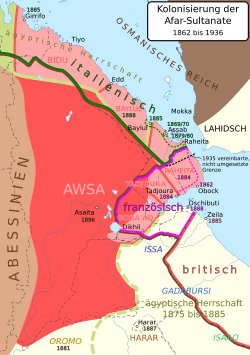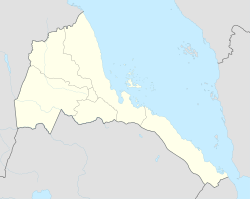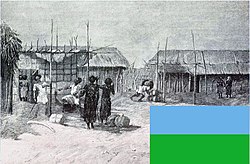Raheita
| Raheita | ||
|---|---|---|
|
|
||
| Coordinates | 12 ° 44 ' N , 43 ° 5' E | |
| Basic data | ||
| Country | Eritrea | |
| Debubawi Kayih Bahri | ||
| ISO 3166-2 | ER-DK | |
|
Residence of the Sultan in Raheita (1885) and presumably the flag of the Sultanate
|
||

Raheita ( Arabic راهيتا), also Rahayta, Rahayto or Rehayto , is a coastal town on the Red Sea near the Bab al-Mandab . The place is one of ten administrative units of the Eritrean region Debubawi Kayih Bahri belonging sub-region South Dankalia (Southern Denkalia). Raheita is about 55 kilometers (as the crow flies) or 70 kilometers (route on the N15) southeast of Assab in the extreme south of the region.
history
Raheita is considered a possible location for the ancient port city of Arsinoe . In the late Middle Ages, Raheita was the residence of the Sultan of Adal , after which Raheita was an independent sultanate under the Adali until the end of the 19th century and also a transhipment point for the slave trade . Other industries were fishing and sea salt production. Today most of the former sultanate belongs to the neighboring Djibouti , but the place itself belongs to Eritrea. At the beginning of the 20th century the place still had about 2,000 inhabitants, now there are only a few hundred. There is still a Sultan of Raheita , but the Sultan and his "vizier" no longer have any administrative powers. Sultan has been Dardar Abdulkadir Dawud since 1994; he was the "vizier" of his predecessor since 1984. The current sultan's deputy and designated successor is "vizier" Abdu Abubakar.
Sultanate of Raheita
The Raheita Sultanate was one of the five Afar Sultanates (Raheita, Aussa , Goba'ad , Tadjoura and Biru / Girifo), which emerged as the successor kingdoms of the Adal Sultanate and of which both Raheita and Aussa claimed sovereignty over the other sultanates . Raheita initially reached from Obock in the south to Assab in the north, and even as far as Baylul . Sultan Dini had already sold most of the Obock region to the French in 1862 , even if his successor Burhan (Berehan, known as Asa Dardar ) subsequently declared in 1870 that the area had only been leased. Burhan, for his part, first sold the Bay of Assab to the Italians in 1879 and 1880 , then in May 1880 all areas north of Ras Sintian.
On September 20, 1880, Burhan signed a treaty with Italy, according to which his sultanate should be placed under the Italian protectorate after his death (and thus above all protected from Egypt). From then on, the Italians' trade with Raheita and its hinterland grew. After Burhan's death, however, despite Italian protests in October 1884, the French also occupied the rest of the Obock region and thus the southern part of the Sultanate of Raheita.In January 1885 the new Sultan Hummad had to cede all areas south of Doumeira to France. Raheita was thus limited to a residual area between Ras Sintian and Ras Doumeira.
Raheita incident
Italy also fought with the Abyssinian Empire for sovereignty over the Sultanate of Aussa, while the Russian Empire, allied with Abyssinia and France, negotiated a naval base on the coast with both the Ethiopian Emperor and the Sultan of Raheita and the Russian gunboat Saporoshez in November In 1896 a division of marines ashore in Raheita. After two Italian-Abyssinian wars, Sultan Hummad rebelled unsuccessfully against the Italians in November 1898. When then marines from the French gunboat Scorpion went ashore in Raheita to also occupy the north of the sultanate, they found the place already occupied by Italians. This confrontation, internationally noted as the "Raheita incident" ( French L'incident de Raheita , Italian L'incidente di Raheita , English Raheita Incident ) was quickly settled. The sultan, who fled to Obock before the occupation of his country, but then returned to Raheita in 1899, was imprisoned by the Italians. In the Franco-Italian agreements of 1900 and 1901, the sultanate was finally divided between French Somaliland (today's Djibouti) and Italian Eritrea , and then in 1902 the remaining northern area of the sultanate, which was occupied by the Italians, was officially annexed.
In July 1934, Sultan Hummad's son Hammad fled into exile from the Italians in the part of the former sultanate that belonged to French Somaliland and set up his residence in Obock. In the Franco-Italian agreement of January 1935, France agreed to some border corrections in favor of Italy in the hinterland of Raheita, but in December of the same year, according to a Franco-British proposal , Raheita was to be handed over from Italy to Abyssinia (Ethiopia). However, the Franco-Italian agreement of 1935 was not ratified and the border areas were never surrendered. Nevertheless, after the independence of Djibouti and Eritrea, an Eritrean-Djiboutian border conflict developed .
Individual evidence
- ↑ more rarely also transcribed as Rahita, Rahaita or Rahayita
- ^ Siegbert Uhlig: Encyclopaedia Aethiopica , Volume 4, Page 324 (Rahayta) . Harrasowitz Verlag, Wiesbaden 2010
- ↑ Eritrea Ministry of Information: Inhabitants of Rehaita called upon to enhance participation in conservation of relics
- ↑ Ania Kotarba-Morley: Ancient Ports of Trade on the Red Sea Coasts , In: Najeeb Rasul, Ian Stewart: Geological Setting, Palaeoenvironment and Archeology of the Red Sea , page 745. Springer Nature, Cham 2019
- ^ Labrousse Henri: Enquêtes et découvertes d'Obock à Doumeira , In: Annales d'Ethiopie. Volume 11, Paris 1978. Pages 75-82.
- ↑ Institut de Stratégie Comparée (ISC): La Mer Rouge de l'Antiqué aux croisades
- ↑ Eritrea Ministry of Information: Southern Red Sea region - the land of Danakils (Part IV)
- ↑ Eritrea Ministry of Information: Southern Red Sea region - the land of Danakils (Part VI)
- ^ Fred Morton: The story of Oromo slaves bound for Arabia who were taken to South Africa
- ↑ a b Raheïta . In: Meyers Großes Konversations-Lexikon . 6th edition. Volume 16, Bibliographisches Institut, Leipzig / Vienna 1908, p. 573 .
- ↑ Eritrea Ministry of Information: The Multifaceted Southern Red Sea Region
- ↑ a b c Didier Morin: Dictionnaire historique afar 1288-1982 , pages 230-235 (Rahaytó) and 264f. KARTHALA Editions, Paris 2004
- ^ Qatar National Library: Italian Proceedings on the African Coast of the Red Sea (1881)
- ↑ Worldstatesmen.org: Rahayto (Djibouti)
- ^ Paul B. Henze: Layers of Time - A History of Ethiopia , p. 175. C. Hurst & Co. Publishers, London 2000
- ↑ Catherine von Raesfeldt: Les relations entre L'Éthiopie et la Russie de 1370 à 1917 , In: Lukian Prijac (ed.): Foreign relations with Ethiopia - human and diplomatic history (from its origins to present) , page 351. LIT Verlag Münster 2015
- ↑ a b Simon Imbert-Vier: Tracer des frontières à Djibouti - des territories et des hommes aux XIXe et XXe siècles , pages 86-96. KARTHALA Editions, Paris 2011
- ^ The Evening Times (Washington) of November 17, 1898: France and Italy once more on good terms
- ↑ Meyers Historischer Handatlas , page 219f. Bibliographical Institute, Leipzig 1911
- ↑ Emmanuel Brunet-Jailly: Border Disputes - A Global Encyclopedia , Part 1, pages 154-159. ABC-CLIO, Santa Barbara 2015
literature
- Eugenio Passamonti: Dall'eccidio di Beilul alla questione di Raheita . Vittoriano, Rome 1937




